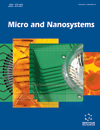- Home
- A-Z Publications
- Micro and Nanosystems
- Previous Issues
- Volume 2, Issue 3, 2010
Micro and Nanosystems - Volume 2, Issue 3, 2010
Volume 2, Issue 3, 2010
-
-
EDITORIAL [Hot topic: Future Emerging Technologies in Microelectronics (Guest Editor:Balazs Illes)]
More LessBy Balazs IllesMicroelectronics is one of the most rapidly progressing fields of engineering science. This multidisciplinary field of science which is prevalent in everyday life. Each year completely new innovations in microelectronics appear in the market which immediately become an important and indispensable part of our life. These innovations increasingly demand precise, fast and cheap production technologies. The aim of this s Read More
-
-
-
Qualification of AgPd Thick Films Using Atomic Force Microscopy
More LessAuthors: Laszlo Milan Molnar, Szabolcs David and Gabor HarsanyiThis paper introduces a method using contact mode Atomic Force Microscopy (AFM) for qualification of AgPd thick films. The described measurement technique is capable of detecting very small concentration of surface contaminants, which can be crucial if the thick film conductor is directly bonded by ultrasonic welding. During this welding process an aluminum wire is pressed vertically onto the thick film surface; a Read More
-
-
-
Illumination Optimization for Quasi-Tombstone Detection
More LessAuthors: Mihaly Janoczki, Andras Borbiro, Sandor Nagy and Laszlo JakabIn this paper we describe a novel approach to optimizing the illumination of Automatic Optical Inspection (AOI) appliances for quasi-tombstone detection. At present, optical testers use LEDs (Light Emitting Diode) for lighting. The properties of LED make it a perfect choice for fast, accurate lighting. Complex illumination systems have been developed to reliably detect each kind of failure; but even so these illumination device Read More
-
-
-
Investigating the Influence of Uneven Printed Wiring Board Surface on Volume Increment of Deposited Solder Pastes
More LessAuthors: Oliver Krammer, Laszlo Milan Molnar, Laszlo Jakab and Andras SzabóThe level differences on the Printed Wiring Board (PWB) surface can keep the stencil away from the PWB during stencil printing, which causes large deposited solder paste volume, and can result in solder bridges after reflow soldering. The level differences can be caused by identity decals, or by other artifacts on the PWB. In our research the effect of these level differences on the deposited paste area and height were investigate Read More
-
-
-
Investigations on Vapor Phase Soldering Process in an Experimental Soldering Station
More LessAuthors: Attila Geczy, Zsolt Illyefalvi-Vitez and Peter SzokeVapor phase soldering (VPS) has been investigated to improve the knowledge about vapor generation, progression and condensation processes. VPS is an emerging reflow method for electronic assemblies, in terms of efficiency and quality. An experimental VPS station was developed for measurements and investigations with applying components and solders of various materials. The flexibility of the system allows custom Read More
-
-
-
Formation and Distribution of Sn-Cu IMC in Lead-Free Soldering Process Induced by Laser Heating
More LessAuthors: Tamas Hurtony, Balint Balogh and Peter GordonThe thickness evolution of Sn-Cu intermetallic compounds (IMCs) in laser reflowed solder joints was investigated. We applied a Q-switched, frequency tripled Nd:YAG laser to precisely control the exposing energy. Sn96.5Ag3.0Cu0.5 lead free solder alloy was heated up by a two-phase, pre-heat and reflow, soldering technique. The microstructure of the solder joint was analyzed with SEM on cross-section samples. We ha Read More
-
-
-
Mapping Heat Conduction Ability of Big SMDs with Dijsktra Algorithm
More LessAuthors: Balazs Illes and Gabor HarsanyiIn this paper we present how the graph theory can be used in the field of thermal study. We have developed a method which can describe the heat conduction ability of big Surface Mounted Devices (SMDs) during the reflow soldering process. Our method established that the heat conduction ability of the materials can be described with time coefficients. These time coefficients are determined by the thermal resistance and th Read More
-
-
-
Numerical Simulation of Droplet-Based Microfluidics - A Review
More LessAuthors: Jing Liu and Nam Trung NguyenThis paper discusses the features and applications of interface tracking techniques for modeling droplet-based microfluidics. The paper reviews the state of the art of methods for tracking and capturing the interface. These methods are categorized as the implicit and the explicit methods. The explicit methods need to reconstruct the interface by reconnecting the markers on the interface. The implicit techniques implicitly descri Read More
-
-
-
Particle Sorting in Microfluidic Systems
More LessAuthors: Guiping Zhu and Nam Trung NguyenContinuous particle sorting is one of the most important microfluidic applications. Fast and accurate sorting procedures can be performed using unique characteristics of microfluidics. Beside hydrodynamic means, provided by the flow itself, the application of an external field also contributes to sorting efficiency. Particle sorting has been realized in many effective ways. This paper systematically gives an overview on technique Read More
-
-
-
Surface Acoustic Wave Driven Microfluidics - A Review
More LessAuthors: Trung Dung Luong and Nam Trung NguyenThis paper presents a systematic overview on the recent works on surface acoustic wave (SAW) driven microfluidics. SAW microfluidics is based on acoustic streaming induced by leaky SAW radiation into a liquid. The development of this field attracts attention from microfluidic research community due to its rapid actuation, programmable capability, simple and yet efficient operation. In our paper, SAW microfluidic applic Read More
-
Most Read This Month
Article
content/journals/mns
Journal
10
5
false
en


